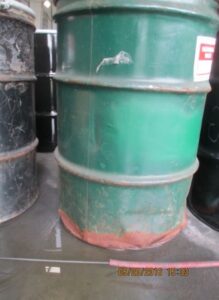Based on a recommendation from commenters, USEPA made a minor wording change to 40 CFR 262.15(a)(1) to explicitly require an immediate response to a leaking or damaged container in a satellite accumulation area (SAA). The revised regulations also clarify the applicable regulations if the container is moved to a central accumulation area (CAA). This change is part of the many revisions to generator regulations made by the Generator Improvements Rule.
The purpose of this article is to explain the addition of the word “immediately” and other language to 40 CFR 262.15(a)(1) regarding containers that are not in good condition or begin to leak.
Before we begin…
- This is one article in a series that reviews all of the changes made to §262.15 by the Generator Improvements Rule.
- The location of these regulations within Title 40 of the Code of Federal Regulations (CFR) was changed by the Generator Improvements Rule. The satellite accumulation area regulations were located at 40 CFR 262.34(c), they are now found at 40 CFR 262.15.
- FAQ: What is a satellite accumulation area?
- FAQ: What is a central accumulation area?
Scope and Applicability:
- Accumulation of hazardous waste in a SAA is an option for both a large quantity generator of hazardous waste (LQG) and a small quantity generator of hazardous waste (SQG). Very small quantity generators of hazardous waste (VSQG) don’t have to comply with SAA regulations per §262.14(a).
|
Not sure of your hazardous waste generator category? |
- These new regulations were created by the Generator Improvements Rule, which may not yet be adopted by your state. FAQ: What is the status of the Generator Improvements Rule in my state?
- A generator may accumulate either or both of the following in a SAA:
- Acute hazardous waste
- Non-acute hazardous waste (aka: hazardous waste).
40 CFR 262.15(a)(1):
(1) If a container holding hazardous waste is not in good condition, or if it begins to leak, the generator must immediately transfer the hazardous waste from this container to a container that is in good condition and does not leak, or immediately transfer and manage the waste in a central accumulation area operated in compliance with §262.16(b) or §262.17(a). (emphasis added)
|
Contact me the next time hazardous waste generator USEPA training is due to expire. |
What’s it mean?
If a container in a SAA is not in good condition or if it begins to leak the generator must immediately do one of the following:
- Transfer the hazardous waste from the leaking or damaged container to one that is in good condition and does not leak. In this case, the hazardous waste would remain in the SAA, but in a different container. The container would continue to be managed according to §262.15.
- Transfer the leaking or damaged container to a CAA managed in compliance with §262.16(b) for a SQG or §262.17(a) for a LQG.
Q: So, if I move the leaking or damaged container to a CAA, I don’t have to repair the container or transfer the hazardous waste to a non-leaking, undamaged container?
A: No. both §262.16(b)(2) and §262.17(a)(1)(ii) read, “If a container holding hazardous waste is not in good condition, or if it begins to leak, the small quantity generator must immediately transfer the hazardous waste from this container to a container that is in good condition, or immediately manage the waste in some other way that complies with the conditions for exemption of this section.” A leaking or damaged container of hazardous waste moved from a SAA to CAA must then immediately comply with the regulations applicable to their generator category which is the same as if the container remained in the SAA.
In effect, USEPA made a slight revision to §262.15 so that the regulations for container management in a SAA match the existing regulations for container management in a CAA.
|
Like this article? Subscribe to my Monthly Newsletter No marketing emails! |
Conclusion:
Another example of USEPA adding a few words to a regulation that have a significant impact. Though always a best management practice, now it is codified that leaking or damaged containers must be immediately managed in a way to prevent harm to persons or the environment.

